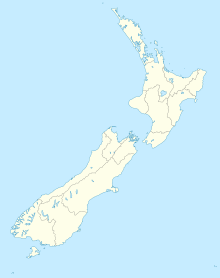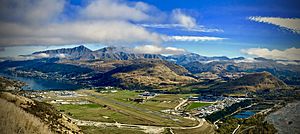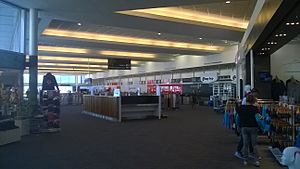Queenstown Airport facts for kids
Quick facts for kids
Queenstown Airport
|
|||||||||||||||
|---|---|---|---|---|---|---|---|---|---|---|---|---|---|---|---|
 |
|||||||||||||||
| Summary | |||||||||||||||
| Airport type | Public | ||||||||||||||
| Owner | Auckland Airport Corp, Queenstown Lakes District Council, Shareholders | ||||||||||||||
| Operator | Queenstown Airport Corporation Ltd. | ||||||||||||||
| Serves | Queenstown, Arrowtown | ||||||||||||||
| Location | Queenstown, New Zealand | ||||||||||||||
| Elevation AMSL | 357 m / 1,171 ft | ||||||||||||||
| Coordinates | 45°01′16″S 168°44′21″E / 45.02111°S 168.73917°E | ||||||||||||||
| Website | queenstownairport.co.nz | ||||||||||||||
| Map | |||||||||||||||
| Runway | |||||||||||||||
|
|||||||||||||||
| Statistics (July 2017 to June 2018) | |||||||||||||||
|
|||||||||||||||
|
Source:
|
|||||||||||||||
Queenstown Airport (IATA: ZQN, ICAO: NZQN) is located in Frankton, Otago, New Zealand, and serves the resort town of Queenstown. The airport is 8 km (5.0 mi) from the Queenstown CBD. The airport handled 2.25 million passengers as of 2018 making it the fourth busiest airport in New Zealand by passenger traffic. The airport consists of two runways, one of which is paved, and has a single-level terminal building with nine gates.
Contents
History
Queenstown Airport was first licensed to operate in 1935, but it was not until the 1950s that commercial flights became commonplace, particularly commercial ‘flightseeing’ operations to Milford Sound. A regular scenic route between Queenstown and Dunedin was first established by Southern Scenic Air Services Ltd on 17 July 1950. Mount Cook Airline was the pioneer of tourist flights into Queenstown.
In the 1960s, the grass runway was lengthened and regular services from Christchurch began on 6 November 1961 operating DC-3s with three flights a week on a Monday, Wednesday and Friday to Queenstown via Mount Cook and onto Te Anau/Manapouri. Services to other domestic destinations soon followed. Later in 14 October 1968, HS-748 aircraft were used which could carry between 42 and 58 passengers.
A mainstay of the Milford route was the Britten Norman Islander which began service in September 1970. They were used extensively on the flights to Milford Sound as well as on the Queenstown-Te Anau and Queenstown-Alexandra-Dunedin routes.
Ansett New Zealand in 1989 starts the first jet aircraft flights (BAe 146 Whisper Jet) into Queenstown Airport. Air New Zealand followed in 1992 with Boeing 737-200 aircraft.
In 1995, Air New Zealand landed Queenstown Airport’s first trans-Tasman flight from Sydney and more flights quickly followed, mainly bringing skiers during the winter. From then on, an almost continuous expansion programme began in order to cater for passenger and airline demand.
The next major milestone was in 2004, when Qantas pioneered RNP AR (Required Navigational Performance, Authorisation Required) operations technology to Queenstown. The precision of the technology significantly improved service reliability which was a considerable benefit to the local community and to visitors.
Since then, passenger growth has been phenomenal and Queenstown Airport is now New Zealand’s fourth busiest airport and one of Australasia’s fastest growing airports. It serves as the direct domestic and international gateway to the lower South Island, providing easy accessibility to Queenstown. The airport even has its own claim to fame as a visitor attraction, being voted ‘World’s Most Scenic Airport Landing’ in 2015 by international private jet booking service PrivateFly.
In PrivateFly.com's 2015 survey to find the world's most scenic approaches, Queenstown Airport received the most votes.
RNP AR flight procedures introduced by Airways New Zealand in 2012, allowed jet aircraft to fly very precise paths in a range of weather conditions, improving airspace capacity and operational efficiency. The advanced navigation technology put in place has been a key enabler for the airport to pursue evening (after-dark) flights.
In May 2014, both New Zealand's Civil Aviation Authority (CAA) and Australia's Civil Aviation Safety Authority (CASA) approved Queenstown Airport's foundation safety case for after-dark flights, contingent on the some additional infrastructure and onboard technology being implemented.
In June 2015, the airport launched its new international terminal and began the rollout of its next initiative - to introduce evening flights by winter 2016. Evening flights will allow the airport to further expand its capacity without building additional terminal infrastructure in the short term and take advantage of its full consented operational hours between 06:00 and 22:00, moving from an approximate 8-hour operating window during the winter peak to a 16-hour operating window. This will spread the peak times more evenly, unlock more opportunities for passengers to access the region, provide locals with more travel options and create job opportunities for the community.
Terminal
Queenstown Airport has a single terminal which handles both international and domestic flights. It has been expanded several times since the 1990s to cope with the introduction of international flights and the rapid increase in passenger numbers. The terminal consists of a single level and does not utilise jet bridges meaning that all access between the terminal and planes entails walking across the apron. An expansion of the international departures area in 2015 included the construction of a mezzanine level to allow for the possible future provision of jet bridges.
Operations
Domestically, Air New Zealand connects Queenstown with Auckland, Wellington and Christchurch while Jetstar Airways operates services to Auckland and Wellington. Auckland is serviced with Airbus A320 aircraft while Wellington and Christchurch are operated by a mix of A320 and ATR 72 aircraft. International flights have grown rapidly over recent years and year-round services operate to Sydney, Melbourne, Brisbane and the Gold Coast. Four airlines operate to these ports: Air New Zealand, Jetstar Airways, Qantas and Virgin Australia. International flights are operated on Airbus A320 or Boeing 737-800 aircraft. The winter season is a very busy one with over 59 direct flights arriving from East Coast Australia on average per week during the peak winter months.
Queenstown Airport is heavily used for tourist 'flightseeing', especially to Milford Sound and Aoraki Mount Cook, and is New Zealand's busiest helicopter port. Weather permitting, there is substantial daily charter traffic of light aircraft (mostly Britten-Norman Islander, Cessna 206, and Cessna 172) to Milford Sound and Te Anau on sightseeing trips. Air Safaris runs a link service to Lake Tekapo Airport. Private jets are also a growing market, both short and long haul, with aircraft now flying direct from north Asia and the West Coast of the United States.
Airlines and destinations
| Airlines | Destinations |
|---|---|
| Air Milford | Milford Sound, Te Anau |
| Air New Zealand | Auckland, Brisbane, Christchurch, Melbourne, Sydney, Wellington |
| Glenorchy Air | Milford Sound, Stewart Island |
| Jetstar | Auckland, Gold Coast, Melbourne, Sydney, Wellington |
| Qantas | Sydney Seasonal: Brisbane, Melbourne |
| Virgin Australia | Brisbane, Melbourne, Sydney |
Statistics
| Rank | Airport | Passengers | Annual change | Carriers |
|---|---|---|---|---|
| 1 | Sydney | 315,596 | Air New Zealand, Jetstar, Qantas, Virgin Australia | |
| 2 | Melbourne | 142,025 | Air New Zealand, Jetstar, Virgin Australia | |
| 3 | Brisbane | 75,856 | Qantas, Virgin Australia | |
| 4 | Gold Coast | 47,098 | Jetstar |
Further upgrades
In July 2011 newly installed runway lights were turned on for the first time. The lighting upgrade was designed to lower diversion rates at the airport due to low visibility. Queenstown is the last major airport in New Zealand to receive such an upgrade. The $2 million project included 34 transformers, 25 km of airfield lighting cable, 124 lights, and was funded by Airways NZ. Until this upgrade, the airport had only Precision Approach Path Indicators (PAPI) available for pilot aid, so flying was limited to daylight hours.
In April 2012 Queenstown Airport opened its new sealed cross-wind runway on the former grass runway; the cost of this project was $800,000 and took 10 months to complete. Sealing the runway reduced the number of disruptions as well as further improved safety."
After announcing expansion plans in 2010, work began in 2014 and the airport opened its new $17 million international terminal on 23 June 2015. The 4,100sqm expansion to the southern end of the terminal building doubled the size of the airport's international operations and features new and improved facilities, products and services. Key features include two new gate lounges which continue the theme of floor-to-ceiling alpine views, a new-look Duty Free store, a state-of-the-art Customs processing area, expanded airside retail outlets, a third baggage carousel and back-of-house handling areas. The new terminal has a mezzanine level on top to enable aerobridges to be included at a later stage.
In November 2015, Queenstown Airport commenced a $17 million series of major airfield infrastructure improvements designed to pave the way for evening flights in winter 2016 and improve overall safety and efficiency of operations.
Strategic partnership with Auckland Airport
On 8 July 2010, Auckland International Airport Limited, the operator of Auckland Airport, announced it had entered into an agreement to take a 24.99% shareholding in Queenstown Airport Corporation Limited and formed a strategic alliance between the two airports. The shareholding cost NZ$27.7 million, through the issue of new shares. The alliance was expected to generate an extra 176,000 passengers through Queenstown Airport.
Auckland Airport has an option to increase its shareholding in Queenstown Airport to 30-35% at any time up to 30 June 2011, subject to the approval of the Queenstown Lakes District Council. The new share capital would allow Queenstown Airport to fund growth of the airport's operating capacity and to pay regular dividends back to the community via the Queenstown Lakes District Council shareholding.







